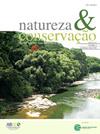High-diversity Atlantic Forest restoration plantings fail to represent local floras
IF 3.5
2区 环境科学与生态学
Q1 BIODIVERSITY CONSERVATION
引用次数: 0
Abstract
One goal of ecological restoration is species conservation, so selecting tree species from local floras in restoration plantings is important to restore native species populations and avoid biotic homogenization. We evaluated if species planted to restore the Brazilian Atlantic Forest adequately represent the tree flora from local reference forests, comparing the tree seedlings selected for 1,073 restoration plantings with inventory data from 268 forest remnants, for three different Atlantic Forest types. We compared the floristic composition between plantings and remnants and calculated the Jaccard dissimilarity index to assess beta diversity among plantings, among remnants, and between plantings and remnants. Overall, plantings have lower beta diversity and higher nestedness than remnants. Furthermore, plantings form a single floristic group while remnants are split into three forest types. Plantings are more floristically similar to one another than to regional remnant forest types. Tree species selected for Atlantic Forest restoration poorly represent local floras, which could favor biotic homogenization. Incentivizing greater representation of local floras and threatened and endemic species is needed for forest restoration to facilitate biodiversity recovery at large spatial scales.

高多样性的大西洋森林恢复植物不能代表当地的植物区系
生态恢复的目标之一是物种保护,因此在恢复种植中选择本地植物群中的树种对于恢复本地物种种群和避免生物同质化具有重要意义。我们评估了用于恢复巴西大西洋森林的树种是否充分代表了当地参考森林的树木区系,将1073个恢复树种的树苗与来自三种不同大西洋森林类型的268个森林遗迹的库存数据进行了比较。通过比较植物区系组成,计算Jaccard差异指数,评价植物区系间、植物区系间和植物区系间的beta多样性。总体而言,与残体相比,植物的β多样性较低,巢性较高。此外,植被形成了一个单一的植物区系群,而残余物则分为三种森林类型。植物在植物区系上彼此之间的相似性大于与区域残余森林类型之间的相似性。为恢复大西洋森林选择的树种不能很好地代表当地的植物区系,这可能有利于生物同质化。为了促进大空间尺度上的生物多样性恢复,森林恢复需要鼓励更多地代表当地植物群、受威胁物种和特有物种。
本文章由计算机程序翻译,如有差异,请以英文原文为准。
求助全文
约1分钟内获得全文
求助全文
来源期刊

Perspectives in Ecology and Conservation
Environmental Science-Nature and Landscape Conservation
CiteScore
7.80
自引率
4.30%
发文量
46
审稿时长
59 days
期刊介绍:
Perspectives in Ecology and Conservation (PECON) is a scientific journal devoted to improving theoretical and conceptual aspects of conservation science. It has the main purpose of communicating new research and advances to different actors of society, including researchers, conservationists, practitioners, and policymakers. Perspectives in Ecology and Conservation publishes original papers on biodiversity conservation and restoration, on the main drivers affecting native ecosystems, and on nature’s benefits to people and human wellbeing. This scope includes studies on biodiversity patterns, the effects of habitat loss, fragmentation, biological invasion and climate change on biodiversity, conservation genetics, spatial conservation planning, ecosystem management, ecosystem services, sustainability and resilience of socio-ecological systems, conservation policy, among others.
 求助内容:
求助内容: 应助结果提醒方式:
应助结果提醒方式:


